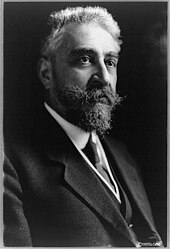Ion I.C. Brătianu
| Ion I. C. Brătianu | |
|---|---|
 |
|
| Prime Minister of Romania | |
|
In office 9 January 1909 – 28 December 1910 4 January 1914 – 28 January 1918 29 November 1918 – 26 September 1919 17 January 1922 – 29 March 1926 21 June 1927 – 24 November 1927 |
|
| Monarch |
Carol I Ferdinand Michael |
| Preceded by |
Dimitrie Alexandru Sturdza Titu Maiorescu Constantin Coandă Take Ionescu Barbu Ştirbey |
| Succeeded by |
Petre P. Carp Alexandru Averescu Artur Văitoianu Alexandru Averescu Vintilă Brătianu |
| Personal details | |
| Born |
Ionel I. C. Brătianu August 20, 1864 Ștefănești, Romania |
| Died | November 24, 1927 (aged 63) Bucharest, Romania |
| Political party | National Liberal Party |
| Spouse(s) |
Maria Moruzi Eliza Știrbey |
| Profession | engineer |
Ion I. C. Brătianu (Romanian pronunciation: [iˈon brətiˈanu], also known as Ionel Brătianu; August 20, 1864 – November 24, 1927) was a Romanian politician, leader of the National Liberal Party (PNL), Prime Minister of Romania for five terms, and Foreign Minister on several occasions; he was the eldest son of statesman and PNL leader Ion Brătianu, the brother of Vintilă and Dinu Brătianu, and the father of Gheorghe I. Brătianu. Ion I. C. Brătianu's political activities after World War I, including part of his third and fourth term, saw the unification of the Old Romanian Kingdom with Transylvania, Bukovina and Bessarabia (see: Greater Romania). In 1923, he was elected an honorary member of the Romanian Academy.
Born at Florica, his father's estate in Ștefănești, Argeș County, he completed his secondary education at the Saint Sava National College in Bucharest (1882). He then volunteered for the Romanian Army's artillery, serving for six months before becoming a Second lieutenant. During his military service, Brătianu studied engineering. He left for Paris in 1883, and attended the Collège Sainte-Barbe, then took classes (without being a registered student) at the École Nationale des Ponts et Chaussées (1884–1889). Brătianu received an engineer's diploma, but not a licence to practice.
...
Wikipedia
